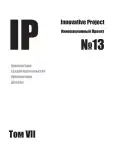Vol 7, No 13 (2022)
URBAN STORIES
The evolution of the symbolic plan in the architecture of kitchen factories of the 1920-1930s
Abstract
A comparative analysis of three kitchen factories built in the 1920s-1930s is carried out - the 1st Moscow kitchen factory on Leningradsky Prospekt, the kitchen factory of the State Aviation Plant No. 1 in the 1st Botkinsky passage in Moscow and factory-kitchen ZiM in Samara. All three kitchen factories were built with the participation of the architect of the share company NARPIT E. N. Maksimova. The purpose of the study is to substantiate the concept of the evolution of the functional and technological structure of the considered factory-kitchens as three stages in the formation of the symbolic plan of the factory-kitchen of the architect E. N. Maksimova in Samara.
 6-19
6-19


Study of factory settlements of the Perm region near the Kama river
Abstract
The formation in the Urals of domestic factory production, which began with the salt industry, as a fundamental fishery in the territory, was considered, and was fully realized in mining industrial metallurgy, which received a whole direction called «Mining civilization». This period gave rise to the spread of new types of settlements City-plants, which were formed around the enterprise, and the territory developed as originally industrial. However, the problem of preservation of some factory settlements and as such enterprises arose for the authorities of the former Molotov region (1940-1957) «Gordian knot», due to the construction of the Kama hydroelectric power plant and the creation of a reservoir, As a result, not only agricultural land and pastures, but also historical settlements, factory areas and many unexplored archaeological sites were flooded. Therefore, in this article the historical, cartographic analysis of former factory settlements was also conducted and the damage of flooding and flooding of territories was revealed, as well as the preserved heritage of «factory civilization».
 20-32
20-32


URBAN SPACE
Options for adaptation of depressive industrial territories of large cities
Abstract
The article discusses the issue of adaptation of former industrial buildings in industrial areas. The world experience of transforming industrial heritage is analyzed, the features of working with these objects are revealed, taking into account their historical value and the recorded legislative status of the cultural heritage object. Options for adaptation of depressed industrial areas have been identified, depending on the degree of influence and intervention both in the architectural appearance of the building and its space-planning structure, and in its urban planning characteristics: restoration with adaptation, new non-capital construction, reconstruction, new capital construction. Models for adaptation of industrial heritage sites in the urban environment are proposed, depending on the interaction of the industrial territory with the city infrastructure.
 34-40
34-40


THE CITY & PEOPLE
Roman Heiligenthal: urban planning of partnership and domination
Abstract
The features of urban settlement, modern Russia and different attitudes towards them in Russian society are considered. The lack of understanding of the underlying reasons for choosing one or another type of settlement is shown. As one of the ways for this understanding, the translation into Russian of the work of the outstanding German urban planner Roman Heiligenthal in 1932, which explains the social prerequisites for such a choice, is given for the first time. A description of his life and work is given, which makes it possible to present his place in German (and World) Urban planning and Regional planning.
 42-55
42-55


CITY IN MOTION
Formation of a transport framework in the historical zones of the largest cities with a functioning center
Abstract
The strategic goals of sustainable development of the historical core in the largest city are aimed at integrating heritage protection policy into the general urban planning policy of economic efficiency in managing changes in the historical urban environment based on the principle of “development through creation.” Two approaches are considered - socially oriented and infrastructural. The object of the study is a sustainable transport and urban framework in the conditions of a functioning city-wide historical center in a number of European cities.
 58-67
58-67


CITY WITHOUT THE CITY
 70-74
70-74


WORKSHOP
Postmodernist collage as a method for regeneration of public spaces
Abstract
Today's times are characterized by an unprecedented emancipation of creative searches, liberation from canons and stereotypes, a fundamental rejection of the traditions of creativity according to one model, a transition to creativity by «intuition» based on the conditions of a specific order, location, capabilities and desires. The modern architect is preoccupied with the creative search for his «element A» (according to K. Malevich), his creative method, which could indicate the path to creating a new form, a new artistic image. The individualistic principle, together with the desire to achieve unique originality in each new work, and at the same time the desire to accommodate cultural and artistic archetypes of various other eras in one volume-spatial architectural object or in a fragment of the urban architectural environment, adding new reinvented meanings to them and through this achieving architectural and artistic integrity directs us to search for new methods of creating diversity and uniqueness. The new method of «Postmodern Collage» now provides such creative possibilities.
 76-80
76-80


BRIEFLY
Digital transformation of cities. Future plans and risks
Abstract
The essay expresses an opinion about the inevitable risks of the process of digital transformation of cities. Digitalization of the living environment and lifestyle affects all spheres of human activity not only in a positive way. This inevitable process is an objective reality, and the speed with which it occurs does not allow us to realize all the risks and prepare for their neutralization. It is assumed that a dialectical understanding of this process with an analysis of the negative consequences will help determine the acceptable framework for digital transformation.
 82-84
82-84











